The Difference Between Foil & Letterpress Printing
May 8, 2025
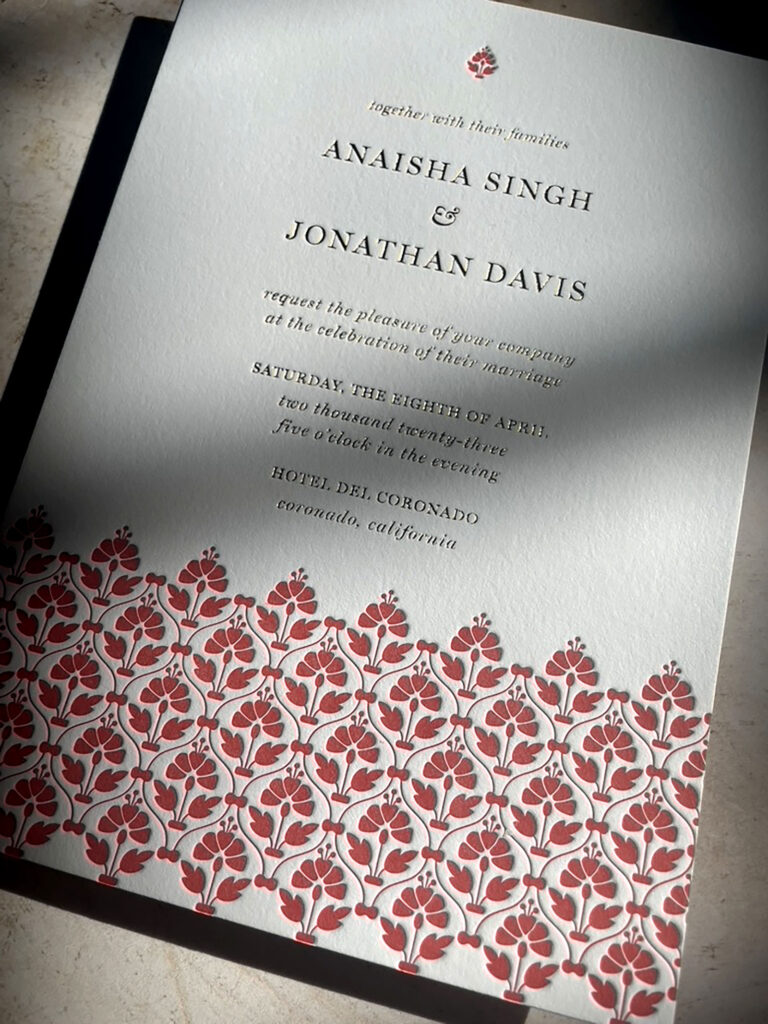
Traducción en Español al final de la publicación*
There’s something quietly powerful about how printing choices shape the feel of an invitation suite. Often, it’s the smallest details that make the biggest difference. One area that tends to cause confusion is the difference between letterpress and foil printing. While they can appear similar at a glance, they each offer something unique. Here’s what sets them apart.
What Is Letterpress Printing?
Letterpress is a traditional printing method where a plate is inked and pressed into the paper, leaving behind a distinct impression (nowadays). You can read more about the ‘correct’ way of printing in our Kiss vs. Bite blog post. It dates back to the 15th century and still holds a special place in the hearts of those who appreciate craftsmanship and history. The result is a beautiful, tactile impression on the paper that feels as special as it looks. The deep impression that letterpress creates adds an extra layer of texture and depth, which gives each piece a unique, elegant feel.
One thing to note about letterpress inks is that they’re translucent, not opaque. This means that pure white ink can’t be achieved with letterpress; foil is needed for that. The ink also behaves differently depending on the paper color. For example, on a pale pastel background, the letterpress ink shows through beautifully, but it may not stand out as much on darker papers. Letterpress is versatile, capable of creating both soft, understated looks and bold, striking designs. Its depth and texture add a unique dimension, whether you’re aiming for something subtle or something that stands out. However, it’s somewhat limited when it comes to certain colors and vibrancy.
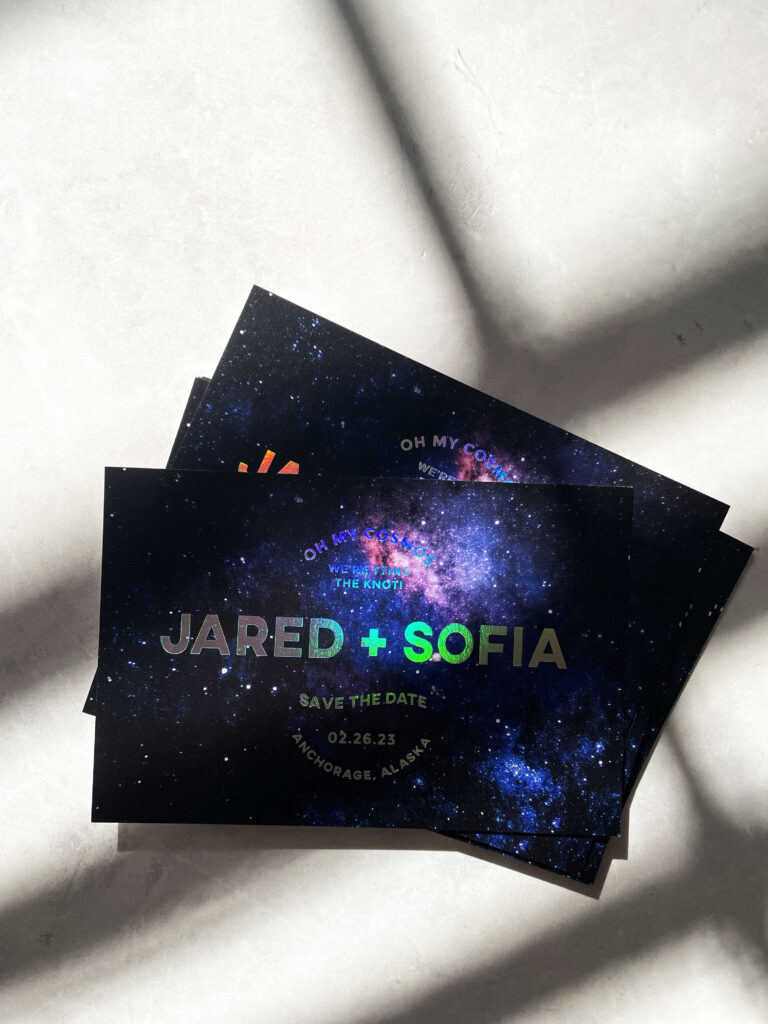
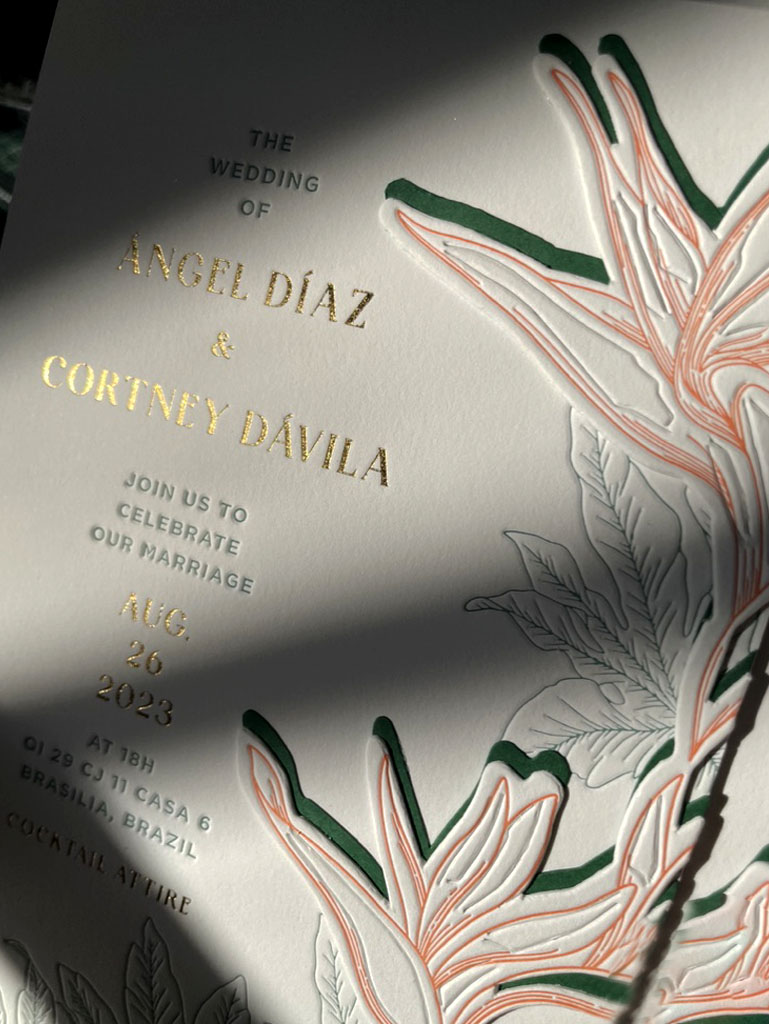
What Is Foil Stamping?
Foil stamping uses heat and pressure to transfer a thin layer of metallic (or pigmented) foil onto paper, creating a gleaming or matte finish. Its versatility is one of its biggest strengths: it can be applied to any paper color and various materials (think leather, fabric, etc.), from soft tones to the deepest, most intense shades. Whether it’s gold, silver, rose gold, or even fluorescent neon colors, foil stamping offers a striking range of possibilities. It creates a stunning contrast, especially on darker papers, with a shine that catches the light in a way that feels almost magical.
Unlike letterpress, foil doesn’t create a deep impression in the paper. Instead, it sits lightly on the surface, offering a sleek, polished finish. Foil allows for printing opaque colors, including white, and is ideal for designs on darker papers, or when you want an extra shine without overwhelming your design.
However, foil printing can be a bit finicky, especially with larger solid areas. Since foil sits on top of the paper rather than soaking into it like ink, large prints may lose some crispness. This can result in a softer, less precise look in certain areas. Careful consideration is needed when planning larger foil designs, especially if your design relies on clean, sharp lines.
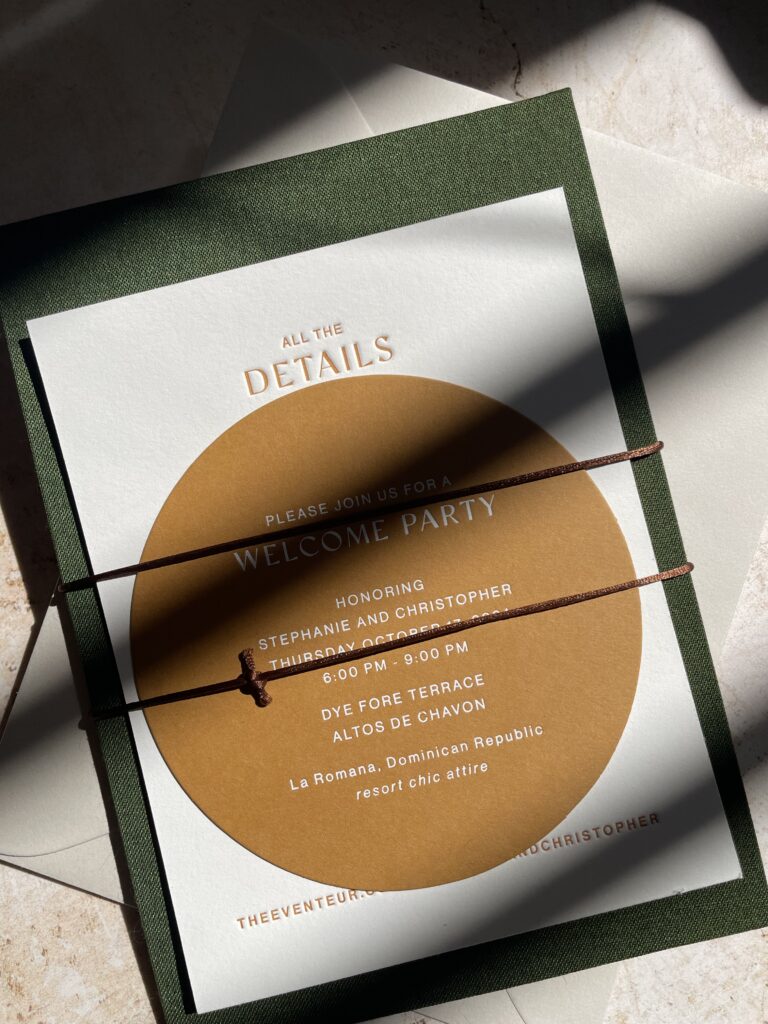
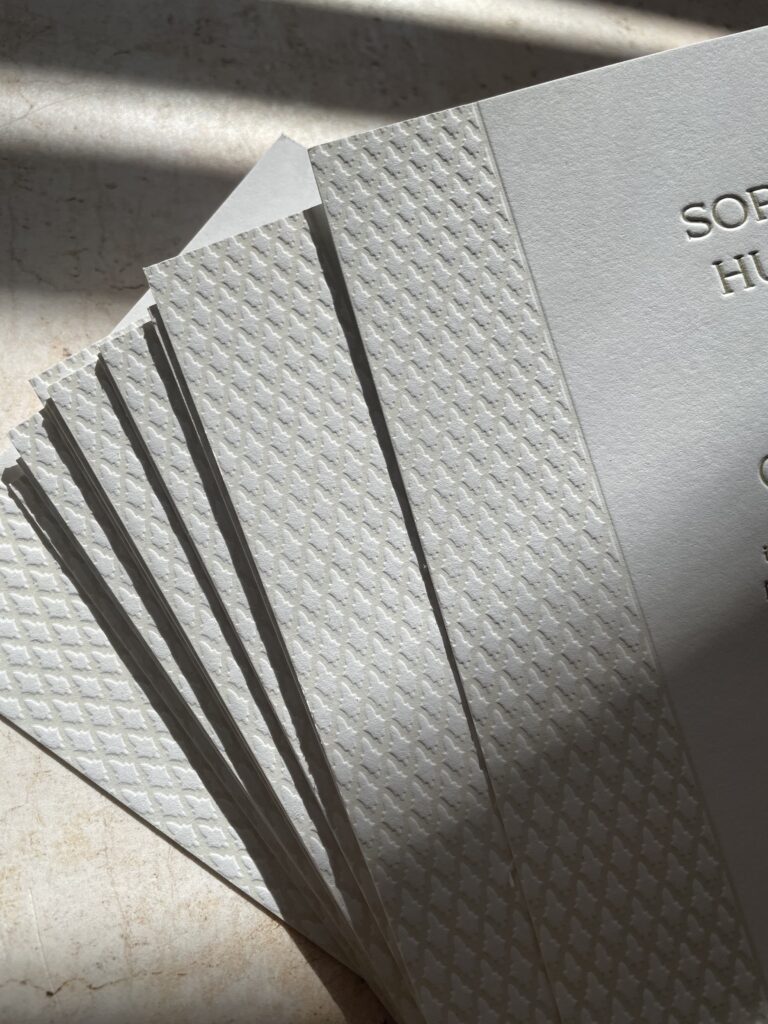
Foil vs. Letterpress: Key Differences in Appearance and Technique
It really depends on your vision and what kind of story you want your invitations to tell. If you’re dreaming of a refined, tactile look with depth and texture, letterpress might be your best friend. If you’re drawn to shine, contrast, or something that pops on darker paper, foil could be the way to go.
Sometimes, the answer is both. Combining foil and letterpress can create a layered effect that feels elevated and thoughtful, like a soft, understated touch paired with a bold, striking highlight.
A Quick Recap:
- Letterpress uses ink and creates a pressed impression, adding depth and texture to the paper.
- Foil uses metallic or pigmented foil for a shiny finish without ink and doesn’t create a deep impression.
- Letterpress uses translucent inks, so it works best on lighter-colored paper and cannot print opaque colors like white.
- Foil can print opaque colors, including white, and is ideal for designs on darker paper or when you want extra shine.
- Foil printing is generally more expensive than letterpress because the materials (plates and foils) cost more. Most printers charge accordingly for the additional setup and materials involved.
At Bodega Press, we take the time to help you explore your options, ensuring your invitations feel true to who you are as a couple. Whether you choose foil, letterpress, or a combination of both, they should reflect your style and the tone you’re aiming for.
Have questions about which option is best for your wedding? Reach out anytime 🙂
La diferencia entre la termoimpresión y el letterpress
Hay algo silenciosamente poderoso en cómo las decisiones de impresión pueden definir el carácter de una invitación. A menudo, son los detalles más pequeños los que marcan la mayor diferencia. Una de las dudas más comunes es la diferencia entre la impresión letterpress y el hot stamping, como se le suele llamar hoy en día a la termoimpresión. Aunque a simple vista pueden parecer similares, cada una ofrece algo distinto. Aquí te explico qué las distingue.
¿Qué es el letterpress?
Letterpress es una técnica de impresión tradicional en la que una plancha entintada se presiona sobre el papel, dejando una huella visible (hoy en día). Puedes leer más sobre la forma “correcta” de imprimir en nuestra entrada del blog Kiss vs. Bite. Esta técnica se remonta al siglo XV y sigue teniendo un lugar especial en el corazón de quienes valoran el oficio y la historia. El resultado es una impresión preciosa y táctil sobre el papel que se siente tan especial como se ve. La profundidad de la impresión añade textura y dimensión, lo que le da a cada pieza una sensación única y elegante.
Un detalle importante: las tintas de letterpress son translúcidas, no opacas. Esto significa que no se puede lograr un blanco puro con letterpress; para eso se necesita hot stamping. Además, el color del papel afecta cómo se ve la tinta. Por ejemplo, sobre un fondo pastel claro, la tinta de letterpress se ve preciosa, pero puede no resaltar tanto en papeles oscuros. Letterpress es una técnica versátil que permite crear desde diseños sutiles hasta composiciones llamativas. Sin embargo, tiene ciertas limitaciones cuando se trata de colores intensos y fluorescentes.
¿Qué es el hot stamping?
El hot stamping utiliza calor y presión para transferir una delgada capa de lámina metálica (o pigmentada) sobre el papel, creando un acabado brillante o mate. Su versatilidad es uno de sus mayores atractivos: se puede aplicar sobre cualquier color de papel y en distintos materiales (piensa en cuero, tela, etc.), desde tonos claros hasta los más oscuros e intensos. Ya sea dorado, plateado, oro rosado o incluso colores neón fluorescentes, el hot stamping ofrece una gama de posibilidades muy llamativa. Crea un contraste espectacular, especialmente sobre papeles oscuros, con un brillo que capta la luz de una forma casi mágica.
A diferencia de la impresión letterpress, el foil no crea una impresión profunda en el papel. En su lugar, se sitúa ligeramente sobre la superficie, ofreciendo un acabado elegante y pulido. El foil permite imprimir colores opacos, incluido el blanco, y es ideal para diseños sobre papeles oscuros, o cuando deseas ese brillo adicional sin sobrecargar el diseño.
Sin embargo, el hot stamping puede ser algo delicada, especialmente con áreas grandes de láminas sólido. Como la lámina se coloca sobre el papel en lugar de impregnarlo como la tinta, las impresiones grandes pueden perder algo de definición. Esto puede dar lugar a un aspecto más suave y menos preciso en algunas áreas. Es necesario considerar cuidadosamente los diseños con hot stamping en grandes áreas, especialmente si tu diseño depende de líneas nítidas y limpias.
Foil vs. Letterpress: diferencias clave en apariencia y técnica
Todo depende de tu visión y del tipo de historia que quieres contar con tus invitaciones. Si sueñas con una estética refinada, con textura y profundidad, el letterpress puede ser tu mejor aliado. Si te atrae el brillo, el contraste o algo que resalte en papel oscuro, el hot stamping puede ser la opción perfecta.
A veces, la mejor respuesta es una combinación. Usar hot stamping y letterpress juntos puede crear un efecto por capas que se siente elevado y pensado al detalle, como un toque sutil acompañado de un acento audaz y llamativo.
Resumen rápido:
- Letterpress usa tinta y crea una impresión en el papel, añadiendo textura y profundidad.
- Foil usa lámina metálica o pigmentada, no tinta, y no crea una impresión profunda.
- Con letterpress las tintas son translúcidas, por lo que no se pueden obtener colores opacos como el blanco con esta técnica.
- El hot stamping permite imprimir colores opacos, incluido el blanco, y es ideal para papeles oscuros o cuando se busca un acabado brillante.
- El hot stamping suele ser más caro que el letterpress porque los materiales (planchas y láminas) tienen un precio más alto. La mayoría de los impresores cobran según el tiempo y materiales involucrados.
En Bodega Press, nos tomamos el tiempo para ayudarte a explorar tus opciones y asegurarnos de que tus invitaciones reflejen quiénes son como pareja. Ya sea que elijas hot stamping, letterpress o una combinación de ambos, deben sentirse como un reflejo de tu estilo y del tono que quieres transmitir.
¿Tienes dudas sobre cuál opción es mejor para tu boda? Estoy encantada de ayudarte. Escríbeme cuando quieras 🙂
Leave a Reply Cancel reply
©2024 BODEGA PRESS - ALL RIGHTS RESERVED
a luxury modern letterpress wedding invitation studio dedicated to conveying beauty discernible not just to the eye, but to the touch.
info
let’s connect
stay in the know of our latest news, tips and offers
back to top
Custom Letterpress Wedding Invitations & Heirloom Stationery. Modern & Colorful letterpress wedding invitations, save the dates and event stationery. Wedding stationery designed and printed by hand in our luxury design and letterpress studio.
Located between Brasilia and Dulles, Virginia. Services offered worldwide.
follow our journey on instagram
LINKED IN